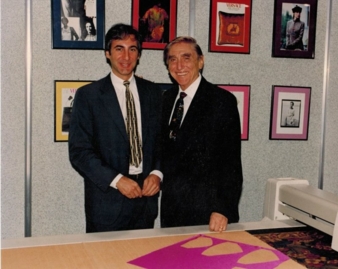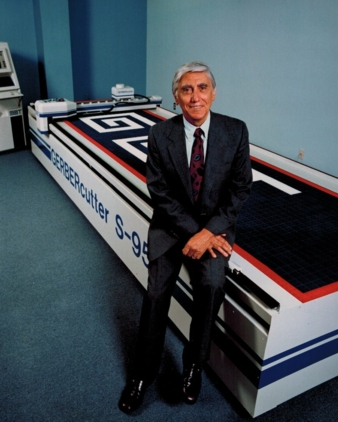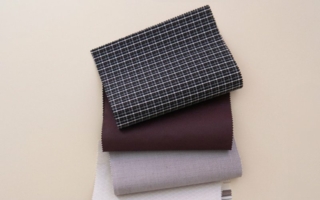21/12/2021 – Transformative Technology
Looking Back Ahead: In Dialog with David J. Gerber – Part II
Asking the father through the son: textile network gained David J. Gerber for an extended mind exchange on current issues and challenges the textile and apparel industry faces.
textile network correspondent Yvonne Heinen-Foudeh along with the son of the inventor and remarkable entrepreneur Joe Gerber, founder of Gerber Scientific and Gerber (Garment) Technology, over several sessions make an attempt to consider: What would Joe Gerber advise today’s decision makers to do?
With this second part of the interview series (read part 1 here) to be addressed: How would this protagonist of so many ingenious developments – hundreds of U.S. and foreign patents, seminal systems for pattern design, digitizing, and grading, lay-out (marker making), fabric spreading, multi-ply fabric cutting, parts-moving, and sewing, not to mention prototyping, networking, and web-based product lifecycle management, in the apparel industry alone – tackle the recent and upcoming fundamental challenge for change? What demand would he have taken up, thus continuing his work as an inventor and innovator?
textile network: Generally speaking, our industry does not have an easy time adapting to market changes, let alone implementing new technologies. Looking back on missed opportunities, people like to point out that ‘the market was not yet ready for the development’.” I recall a chapter in your book about the life and work of your father, where you describe, ‘In 1968 while driving home, Joe Gerber often would contemplate why the apparel industry was proving so difficult to penetrate – even the narrow step of grading patterns, even for IBM’. And yet he and his management team launched almost all of the revolutionary innovations in apparel manufacture worldwide. What can the industry and possibly its suppliers for technology learn for the journey to Industry 4.0 from the protagonist of Industry 3.0 and take up from the Joe Gerber strategy?
David J. Gerber: A main lesson is that technology diffusion may sometimes be even more challenging than technology creation. When my dad introduced his first products for apparel manufacture around 1970, the industry was non-automated. It was comprised mostly of small, thinly-capitalized firms, knotted in supply relationships and influenced by a strong cutters’ union that vowed to stop my dad. Manufacturers were unfamiliar with automation technology. Some trade show attendees actually bent down and looked under my dad’s cutting table, expecting to find a man pulling cables to control the knife movement! When an order came in, manufacturers would hire more cutters until the job was done.
My father’s concept for automated cutting required fundamental changes. It cost a half million dollars, required programmers and technical support, and necessitated mass production business practices to keep the machine running constantly. With manual cutters costing only $3.50 per hour, the cost justification relied savings of material (tighter nests) and sewing labor (more accurate parts) and the promise of systemic efficiencies. What’s more, my father’s concept -– the concept that ultimately unlocked apparel automation after a century of attempts – relied on his vision of a new system comprised of multiple components. But these components had to be introduced one at a time. So systemic efficiency was a vision, not a reality, at first. Meanwhile, the new products disrupted operations because they changed the manufacturer’s workflows.
textile network: So how did your father and his team succeed in this industry despite all these extraordinary challenges?
David J. Gerber: They employed four types of strategies. Their first strategy involved missionary marketing: creating new cost accounting models, forming deep relationships with customers, and engaging in educational and consultative selling to help customers reconfigure their workflows for automation. Their second strategy was to develop key components of the new system fast. Within three years, they introduced automated machines to produce graded pattern stencils, plot nested markers, cut fabric, and sew parts. Their third strategy was to develop interfaces and workarounds to allow manufacturers to maintain existing workflows until ready to move further toward automation. Their final strategy was to identify and exploit deep strategic imperatives of the stakeholders. For manufacturers, this was to neutralize the power of cutters’ unions, which could shut down a factory. For the union leaders, it was to convince them that automation was in labor’s long-term interest.
The questions on behalf of textile network were asked by Yvonne Heinen-Foudeh.
Continue reading on our website on January 4, 2022.
Our Dialog Partner
David Gerber, Joe Gerber’s son, trained as an engineer and attorney, was an officer and a director of Gerber Scientific, Inc., the parent company of Gerber Garment Technology (renamed Gerber Technology in 1995) and of several other subsidiaries, through the 1980s and ‘90s. Thereafter, David was a visiting fellow at the Yale School of Management and wrote the biography of his legendary inventor and entrepreneur father. Most recently, he has been a fellow at Trinity College, Hartford. He describes, with precision that only an engineer and lawyer can muster, Joe Gerber’s life’s work as he provides a history of computer automation. With this precision, he also points out that his perspective is largely historical as he is “not an insider in today’s apparel industry”.





